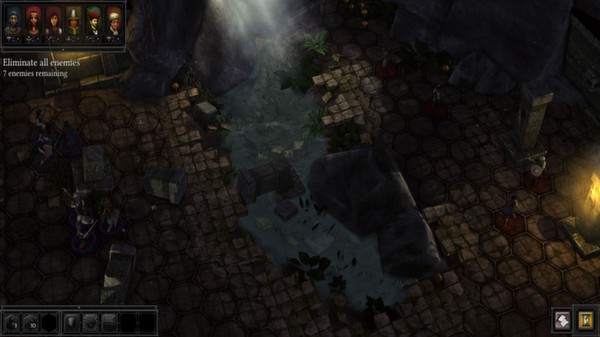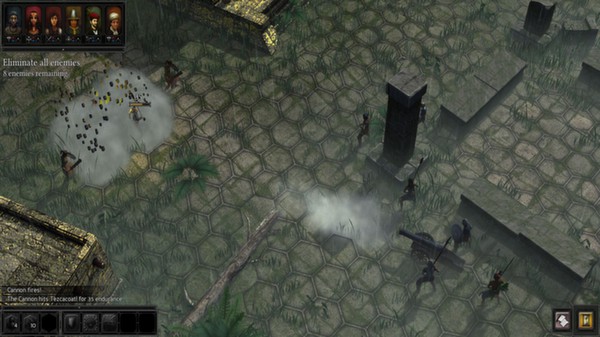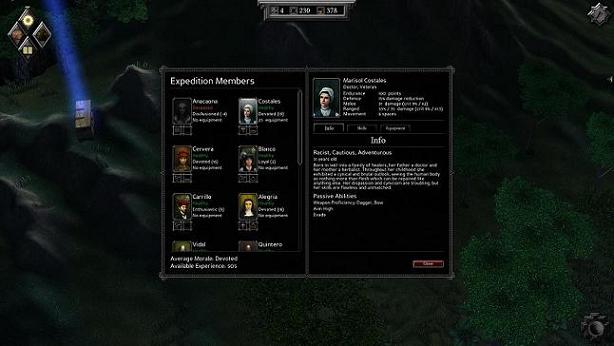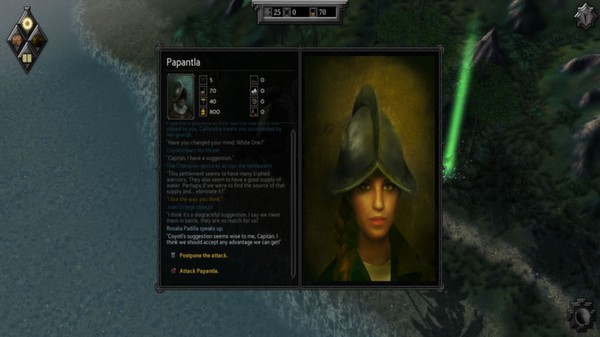At its heart, Expeditions: Conquistador is an RPG about exploration. Yes, there is a story, with quests and a surprisingly solid turn-based combat system, but most of your time will consist of exploring a new and uncharted world. In many ways, it feels like the recent King’s Bounty games, if you set them during the Age of Discovery.
Expeditions: Conquistador starts out by letting you select your crew before departing for the New World. You are a conquistador leading an expedition to Mexico, a few years before Cortés. The game is divided into two campaigns: Hispaniola and Mexico. There is plenty of content here, as both campaigns combined will take you well over 20 hours to complete, if you are really interested in trying to find everything.
Your time in Expeditions will be divided into several basic parts: Exploring the map, managing your party and resources, dialogue screens, and combat. Exploration is by far the dominate of these activities. You can move a set number of times around the map before you must stop and set up camp for the night, which leads into the party management system. Your characters have many important uses outside of combat, which comes into play when you set up camp. You’ll have to protect your camp with guards, send out patrols to look for anything interesting in the area, establish a hunting party to find food to supplement your rations, and so on. Each character has stats that determine how good they are at these tasks, which is in turn dictated by their class. Soldiers make better guards, while Doctors can heal injured characters or turn herbs you find into medicine. This character management can occasionally get tedious, though luckily the game remembers who you had assigned to what task last time you set up camp, so you won’t need to make too many changes each night.
As you’d expect from a game about leading expeditions deep into uncharted jungles, resource management is a pretty big part of the game too. You have four primary resources, four secondary resources for the crafting system, and two perishable resources. Valuables (In other words, gold), medicine, rations, and equipment are the main resources. Valuables are your main currency, though you can use other resources for trading as well. Medicine is used to patch up injured characters. Rations are used to feed your expedition whenever you set up camp. Equipment is how gear is portrayed in the game. Unlike most RPGs where you find actual sets of armor or weapons to equip you characters, here you just have this generic “equipment” resource that you allocate to your primary fighters that increases their attack damage or damage reduction.
Wood, rope, metal, and oil are all used to craft traps and barricades that aid you in combat. This is typically done by allocating someone to “tinkering” when you set up camp, but some merchants also sell traps. These traps are deployed before battle and range from damaging spike traps, to net traps that immediately end an enemy’s turn should they enter them. The perishables are meat and herbs. Meat is gained by sending out hunters, and any extra meat must be preserved and turned into rations before it spoils. Herbs never spoil, and are used to create medicine.
The actual exploration can be very compelling, at least when you are making interesting discoveries. It can have that addictive “one more turn” quality to it at times, but it gradually becomes rather tedious the further you get into the game. Sometimes you just aren’t finding anything interesting, or sometimes you just want to get back to town to turn in a quest. A fast travel system could have helped here, but at the same time I understand that such a feature could have been hard to implement because of how the resource and party management works. The camera is also a bit of a problem here. You can’t zoom out very far, making navigation a bit more difficult than it should be. Still, the game does an admirable job of trying to keep exploration fresh with random events, optional ruins to discover, and resources scattered about.
The combat is solid, if fairly standard for a turn-based, grid-based system. Each character can move and perform one action in a turn, or sacrifice their action to move extra spaces. Characters can have up to five special skills, based on their class and rank. One nice part of the combat is how clear and unambiguous it is about line of sight and cover, something that not all games pull off very well (I’m looking at you, XCOM: Enemy Unknown). One complaint I do have is, once again, about the camera. Buildings and trees don’t become transparent when units are behind them, making it hard to get the camera into a position where you can properly see what is going on in some maps.
The combat also isn’t particularly hard, at least on normal. There were only a handful of times, mostly in the Hispaniola campaign, where I found a battle to be challenging. Combat isn’t properly balanced over the two campaigns either. The campaigns are designed to be somewhat standalone, but your progress in Hispaniola is saved when you go into Mexico. This means that you’ll absolutely dominate battles in Mexico because of all the experience and equipment you gained in the first campaign.
Character progression is a bit lacking as well. You gain experience throughout the game that you spend to promote characters. With each promotion, the character learns a new ability, you get to pick one perk from a list of a few dozen or so, and you get some points that you can allocate to their noncombat skills. My problem here is that there is nothing really unique about each character, at least as far as stats, performance, and abilities go. Of the five combat abilities that a character can learn, the first three are dependent on class and the last two depend on if the character is promoted to sergeant or lieutenant. So, a Soldier will always learn Perfect Defense, Stun, and Guard. The only way you can really individualize characters is with perks, but the perk pool is once again the same for each character. I understand that the game is most likely designed this way because of the sheer number of characters you can get, and the fact that characters can potentially die if their injuries aren’t treated, but I would have liked more ways to make each character’s role a bit unique.
The role-playing in this RPG is fairly well done. There are no cutscenes or voice acting in Expeditions. The story is conveyed through written text, dialogue choices, and pretty nice-looking character portraits. You are given a decent degree of freedom in conversations, and there are some pretty tough choices to be made. Members of your expedition will occasionally pop up during dialogue to voice their own opinions, which adds personality to each character where it is otherwise lacking in the progression side of the game. You’ll also occasionally get random events when you set up camp that allow you to converse with members of your expedition.
As well-written as the characters, dialogue, and story are, I do think that the developers missed an opportunity to craft a more meaningful and provocative experience. In hindsight, this period in history was a very dark time for the natives of the foreign lands that were discovered and conquered by European explorers. These issues are certainly common throughout the game, and many characters in your expedition may seem like terrible human beings by today’s standards, but the game still allows you to approach it a bit too much with a modern mindset. There are a surprising number of open-minded, tolerant characters in the game. So many, that you can easily make an expedition that consists entirely of such characters and develop a very friendly, positive relationship with the natives, something that seems a bit bizarre given the time period. Oh, make no mistake, you can still play as a complete monster in this game, but I feel that the game allows you to skirt too many of the issues inherent with the time period. It all just feels rather jarring, and it is hard to explain what I really mean without playing the game for yourself. With that said, you do still encounter many tough moral choices, especially in the Mexico campaign.
Expeditions: Conquistador is just a bit of missed potential shy of being a really great game. Some mechanics are a bit wonky and tedious, and there are a lot of interesting ideas in the game that just aren’t as fully realized as I wish they were. Expeditions is by no means a bad game, and in fact I found it compelling enough to recommend it at its current $20 price tag. I just feel that, with some changes here and there, it could have been so much better. As it stands, Expeditions: Conquistadors is “merely” a pretty good game instead of a truly great one. You can grab a copy right now on GOG.com or Steam.








